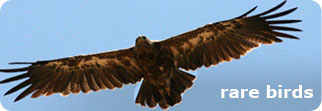 Imperial Eagle (Aquila heliaca) is one of the most rare birds of prey of Europe. Its range spans from NE Europe to Lake Baikal and northern Pakistan. In Europe, the species occurs mainly in the Carpathians, south and east Balkans, hills and steppes of NE Ukraine and Russia.
Imperial Eagle (Aquila heliaca) is one of the most rare birds of prey of Europe. Its range spans from NE Europe to Lake Baikal and northern Pakistan. In Europe, the species occurs mainly in the Carpathians, south and east Balkans, hills and steppes of NE Ukraine and Russia.
The European population was estimated at 363-604 pairs. Recent research, however, in the unknown nature of Eastern Europe, overthrew the data, as in European Russia alone the population is estimated at 600-900 pairs. As a result, the species is no longer considered as Globally Vulnerable, as the limit for this classification is only 1,000 birds.
In its southern distribution, however, Imperial Eagle faces many problems and its decline continues. In Greece, it is stated, according to the Red Book, as an Endangered Species and it is doubtful if it still nests. Of course it still breeds, despite its continuous decline, in neighboring countries (except, perhaps, from Albania) with 15 pairs in FYROM, 20-25 pairs in Bulgaria and 10-50 pairs in Turkey.
Imperial Eagle is mainly a migratory species and a great part of the European population winters in the Middle East. In Greece, birds from northern countries, mainly juvenile, visit and sometimes winter in fairly large wetlands such as Kalamas Delta, Lake Kerkini, Messolongi Lagoon, Axios Delta, Evros Delta and Crete. During migration, it is observed, always in small numbers, even in Peloponnese and a few islands.
Imperial Eagles used to be much more widespread as a breeding species in Greece. During the last century, Reiser, Kruper, Lilford, Lindmayer, Erhard and other researchers watched the species breed in flat areas of northern and central Greece, including Attica, Akarnania and Thessaly. At the same time, there are observations of the species from Peloponnese, Evvoia and Ionian Islands, even though nesting was never proven in those areas.
At the first decades of the 20th century, Imperial Eagle occurred in good numbers in margins of plains of central and northern Greece, favored by traditional land use and especially cattle raising in flat and semi-mountainous areas. This condition lasted until the ‘40s, during which, only near Thessaloniki, as Makatsch mentions, 25 pairs bred, mainly in the area of the triple Axios-Loudias-Aliakmon Delta.
 Things started to change, however, after the war, with wetlands’ drainage, intensification of agriculture and the gradual abandonment of low-level cattle raising, which constitute Imperial Eagle’s space.
Things started to change, however, after the war, with wetlands’ drainage, intensification of agriculture and the gradual abandonment of low-level cattle raising, which constitute Imperial Eagle’s space.
The replacement of rich traditional rural landscapes by monoculture, led to the reduction in the population of species, as the European Souslik which constitute a major food source, and has contributed to the removal of many mature trees uses for nesting. The dramatic shrinkage of plain forests and wetlands’ drainage might had the most adverse effects.
As a consequence of these dramatic changes in Greek countryside, Imperial Eagle dramatically declined during the ‘60s. In the ‘70s and the ‘80s, the species bred mainly in Thrace and perhaps in Macedonia and according to research, at 1980-85 the Greek population was estimated at 6-10 pairs. In 1986, only 2 pairs were left in Evros area, while the last confirmed nesting were made in Dadia forest in 1991.
In late June 1996, during a field research from members of HOS, two adults and one juvenile bird were observed in Mt Tsamantas, in the borders with Albania. In 1997, on the grounds of a research program for Imperial Eagle, its presence in the area was reconfirmed with two adults observed on April 18, 1997. However, there was no further observation of these birds, despite the efforts.
Imperial Eagles are of course protected by law (Decision 414985/1985 MiAg), but reality is completely opposite. The fact that it occurs in flat, easy to approach, areas makes it very vulnerable to hunting. Every year, the Hellenic Wildlife Hospital receives one juvenile bird hit by gunshot, while the total number of Imperial Eagles has gone to 10 birds in 15 years, a very large number for such a rare species.

Young Imperial Eagle, returns to Dadia Forest after recovering at the Hellenic Wildlife Hospital
Due to its occasional feeding with carcasses, Imperial Eagle is very vulnerable (as many large birds of prey) to poisoned baits used for the control of carnivorous mammals, like foxes and wolves. There are valid suspicions that the last pair that nested in Dadia forest, was wiped out by poisons.
During the research of 1997, there was a very serious incident with baits in Tsamantas, with two dead Egyptian Vultures (Neophron percnopterus), bringing pessimistic thoughts to the members of the mission about the fate of the two Imperial Eagles.
Notable threats in other countries are collision to electric wires and snares, but it is not known if there are such incidents in Greece. Trade of eggs and birds is increasing in many countries. In our country, the extent of this problem is unknown, as there is no organized guarding. However, cases of wild fauna trade are being multiplied, mainly by foreigners.
From the experience gained from the research of 1997, it arises that the areas visited greatly maintain the qualitative characteristics required by Imperial Eagle and that with the proper management and taking of measures, resulting from the Action Plan, the species many re-establish in the future a breeding population.
Indeed, adult Imperial Eagles’ observations are increasing year in year out. In early March 1999, two adults were sighted playing in the area between Parnassus and Giona, while at the same in Dadia a member of an Imperial Eagle pair was observed carrying a branch. In 14/4/99, during a visit in Tsamantas-Farmakovouni area, a pair of large eagles was observed. Even though it was not full confirmed whether they were Imperial Eagles, the evidence reinforce this probability. These indications, although they are not adequate for conclusions, have filled Greek ornithologists with hopes that this species will nest again in Greece. We will be ready to protect it.
Our country is obliged, according to the Action Plan, to advance to:
- The extension of the network of protected areas and the management of the primary sites of the species.
- The promotion of a restoration plan for Imperial Eagle.
- The characterization of areas in which Imperial Eagle occurs (breeds or winters) as Special Protection Areas (SPA) based on Directive 79/409/EC
- The enforcement of the prohibition of poisoned bait use.
- The research of the former distribution of the species.
- The close monitoring of Imperial Eagle’s breeding.
- Actions for information and sensitization of the public, especially for the problem that this species faces with hunting.
Photographs: Ben Hallman, HWH


 Imperial Eagle (Aquila heliaca) is one of the most rare birds of prey of Europe. Its range spans from NE Europe to Lake Baikal and northern Pakistan. In Europe, the species occurs mainly in the Carpathians, south and east Balkans, hills and steppes of NE Ukraine and Russia.
Imperial Eagle (Aquila heliaca) is one of the most rare birds of prey of Europe. Its range spans from NE Europe to Lake Baikal and northern Pakistan. In Europe, the species occurs mainly in the Carpathians, south and east Balkans, hills and steppes of NE Ukraine and Russia. Things started to change, however, after the war, with wetlands’ drainage, intensification of agriculture and the gradual abandonment of low-level cattle raising, which constitute Imperial Eagle’s space.
Things started to change, however, after the war, with wetlands’ drainage, intensification of agriculture and the gradual abandonment of low-level cattle raising, which constitute Imperial Eagle’s space. 

